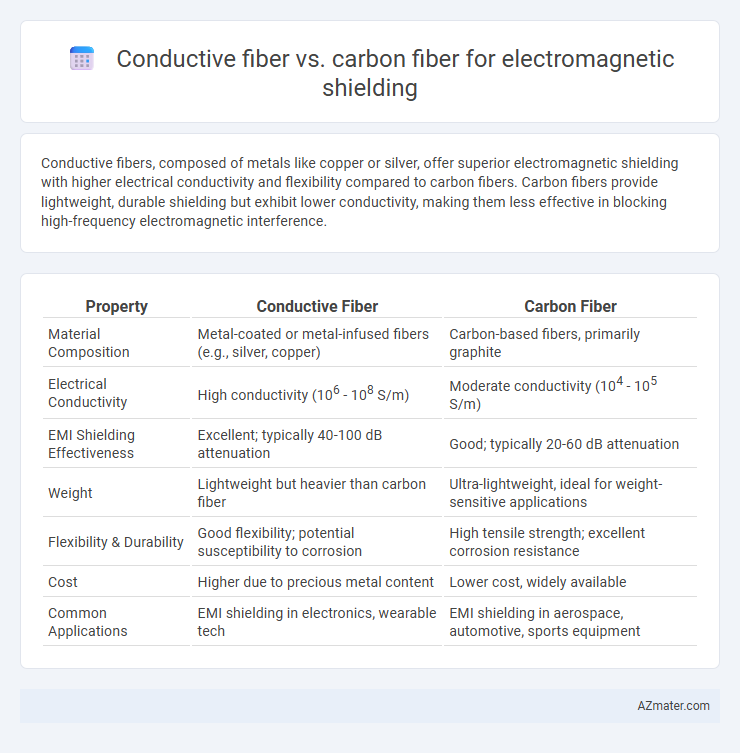Conductive fibers, composed of metals like copper or silver, offer superior electromagnetic shielding with higher electrical conductivity and flexibility compared to carbon fibers. Carbon fibers provide lightweight, durable shielding but exhibit lower conductivity, making them less effective in blocking high-frequency electromagnetic interference.
Table of Comparison
| Property | Conductive Fiber | Carbon Fiber |
|---|---|---|
| Material Composition | Metal-coated or metal-infused fibers (e.g., silver, copper) | Carbon-based fibers, primarily graphite |
| Electrical Conductivity | High conductivity (106 - 108 S/m) | Moderate conductivity (104 - 105 S/m) |
| EMI Shielding Effectiveness | Excellent; typically 40-100 dB attenuation | Good; typically 20-60 dB attenuation |
| Weight | Lightweight but heavier than carbon fiber | Ultra-lightweight, ideal for weight-sensitive applications |
| Flexibility & Durability | Good flexibility; potential susceptibility to corrosion | High tensile strength; excellent corrosion resistance |
| Cost | Higher due to precious metal content | Lower cost, widely available |
| Common Applications | EMI shielding in electronics, wearable tech | EMI shielding in aerospace, automotive, sports equipment |
Introduction to Electromagnetic Shielding
Electromagnetic shielding relies on materials that can effectively block or attenuate electromagnetic interference (EMI) to protect electronic devices. Conductive fibers, typically made from metals like copper or silver, offer excellent electrical conductivity and flexibility, making them suitable for lightweight, flexible shielding applications. Carbon fibers provide good EMI shielding through their conductive graphitic structure, combined with high strength and low weight, but generally exhibit lower conductivity than metal-based conductive fibers.
Overview of Conductive Fiber Materials
Conductive fiber materials such as copper, silver, and stainless steel fibers are widely used for electromagnetic shielding due to their excellent electrical conductivity and flexibility. These fibers can be woven into textiles or composites, creating lightweight, breathable, and durable shielding solutions suitable for wearable electronics and aerospace applications. Compared to carbon fiber, which offers moderate conductivity and high structural strength, conductive fibers provide superior shielding effectiveness against electromagnetic interference, especially in high-frequency ranges.
Properties and Structure of Carbon Fiber
Carbon fiber exhibits high tensile strength and excellent electrical conductivity due to its graphitic crystalline structure, making it an effective material for electromagnetic shielding. Its tightly packed carbon atoms arranged in hexagonal patterns facilitate efficient electron mobility, enhancing shielding effectiveness against electromagnetic interference (EMI). Unlike common conductive fibers, carbon fiber maintains low weight and thermal stability, offering superior durability in shielding applications across automotive, aerospace, and electronics industries.
Electromagnetic Shielding Mechanisms
Conductive fibers shield electromagnetic interference by reflecting and absorbing electromagnetic waves through their high electrical conductivity, which dissipates the energy as heat. Carbon fibers provide shielding primarily via absorption mechanisms enabled by their complex microstructure and dielectric properties, attenuating electromagnetic waves through multiple internal reflections. The combination of reflection and absorption in conductive fibers generally results in higher shielding effectiveness compared to the predominantly absorption-based mechanism of carbon fibers.
Conductive Fiber Shielding Effectiveness
Conductive fibers, composed of materials like silver, copper, or stainless steel, demonstrate high electromagnetic shielding effectiveness due to their excellent electrical conductivity and flexible textile integration. Compared to carbon fibers, conductive fibers provide superior attenuation of electromagnetic interference (EMI) across a broad frequency spectrum, making them ideal for wearable electronics and flexible shielding applications. Their conductive networks enable effective reflection and absorption of electromagnetic waves, achieving shielding effectiveness often exceeding 60 dB in thin, lightweight fabric form factors.
Carbon Fiber Shielding Capabilities
Carbon fiber exhibits superior electromagnetic shielding effectiveness due to its high electrical conductivity and unique woven structure, which dissipates electromagnetic interference (EMI) more efficiently than standard conductive fibers. Its carbon-based composition allows for effective attenuation of both electric and magnetic fields, making it ideal for applications requiring lightweight, durable shielding materials. The shielding performance of carbon fiber composites typically ranges from 30 to 60 dB in the frequency spectrum of 1 MHz to 10 GHz, outperforming many alternative conductive fibers used in EMI protection.
Comparative Analysis: Conductive vs Carbon Fiber
Conductive fibers exhibit superior electrical conductivity and flexibility, making them highly effective for electromagnetic shielding in wearable and flexible electronics. Carbon fibers, while offering excellent mechanical strength and moderate shielding effectiveness, generally provide lower conductivity compared to metallic conductive fibers. The choice between conductive and carbon fiber depends on the balance of required shielding performance, mechanical properties, and application-specific flexibility.
Applications in Industry and Technology
Conductive fibers, composed of metal-coated polymers or intrinsically conductive polymers, provide flexibility and lightweight solutions for electromagnetic shielding in wearable electronics, medical devices, and aerospace applications, ensuring effective interference mitigation and signal integrity. Carbon fibers, known for their high strength-to-weight ratio and excellent electrical conductivity, are widely used in automotive, aerospace, and telecommunications industries to shield sensitive components from electromagnetic interference (EMI) while adding structural reinforcement. The choice between conductive and carbon fibers depends on application-specific requirements such as mechanical durability, conductivity level, weight constraints, and environmental resistance.
Cost and Manufacturing Considerations
Conductive fibers such as stainless steel or silver-plated yarns generally offer lower material costs and simpler integration into textile manufacturing processes compared to carbon fibers, which require energy-intensive production methods. Carbon fibers provide superior electromagnetic shielding effectiveness and mechanical strength but involve higher expense due to complex precursor materials and high-temperature treatment steps. Manufacturing conductive fiber composites benefits from flexibility and scalability, while carbon fiber composites demand specialized equipment and longer processing times, impacting overall production costs and lead times.
Future Trends in Electromagnetic Shielding Fibers
Conductive fibers, typically composed of metals like silver or copper coated on textile substrates, offer flexibility and excellent electrical conductivity for electromagnetic shielding with future advances aiming at enhancing durability and integration into wearable technology. Carbon fibers provide superior mechanical strength and electromagnetic interference (EMI) shielding effectiveness, driven by developments in hybrid composites combining carbon and conductive polymers to improve flexibility and conductivity. Emerging trends focus on nanomaterial-infused fibers and smart textiles that enable dynamic EMI shielding responses, promoting multifunctional applications in aerospace, telecommunications, and wearable electronics.

Infographic: Conductive fiber vs Carbon fiber for Electromagnetic shielding
 azmater.com
azmater.com